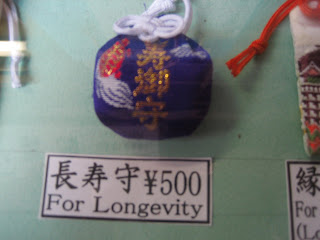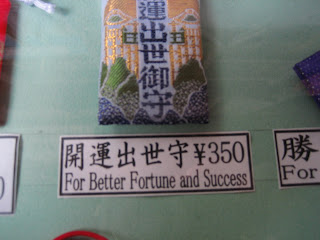Spring is upon us. Last Friday was the official first day of spring in Japan, and all people are getting excited about Hanami ("Looking at the Flowers") Season, aka Sakura Season. Hanami actually is when Japanese people go out of the office/university in droves to sit under blossoming cherry blossoms, and get blind-drunk. It is widely-regarded as the most auspicious time of year to start anything.Since this is the start of the new financial year, new graduates employed by companies typically get the task of staking out a good spot for their office, putting some cushions on the ground, and sitting there - for ages - until everyone else turns up. So, what better time than now to go to Kyoto?
 This is the Kiomizu (clear water) shrine. Rated (by me) as the Kyoto's top temple, above even the Golden Temple.
This is the Kiomizu (clear water) shrine. Rated (by me) as the Kyoto's top temple, above even the Golden Temple. Look - our first Sakura tree!

Coming up to the temple there are some ladies dressed up as Geisha posing for photos in front of a cherry blossom. I felt that this was very Japanese.
 Now, here we are, the view from the Kiomizu. Not bad at all.
Now, here we are, the view from the Kiomizu. Not bad at all.

But, enough of this wandering around. We're here for real business.
This lady is selling Omikuji (fortune-telling pieces of paper) inside the temple. 100Yen per fortune told.

You shake this old-school box, and out comes...
 ...a stick with a number on it!
...a stick with a number on it!

I got number 17.The lady hands you the appropriate paper.My fortune is ....... "BAD" !!! 
It says:
- You have to be very conservative
- Any enterprise undertaken, even if you struggle a lot, will lead to poverty
- If you are ill, you should not change your doctor or medicine
- It will be difficult for you to be happy
- If you sue someone, you'll lose, so it is better to be careful
- If you've lost something in water, or in a dark place, it will be hard to find
- If you fight with someone you will lose, or if you win, you will soon encounter difficulties
- Be careful, you may die (!)
Now, as you may imagine, I wasn't entirely happy with these prognostications.
Thankfully, mercifully, if you don't take the Omikuji home, then you can forget about it. However, you must tie it to a tree. I don't know why. Perhaps the bad news will get bored of being tied to the tree. Or the tree may eat it (I'm just speculating here).
But then, just as I was going to tie the bad news away on a tree branch:
"Please do not tie Omikuji to tree branches" .... What now?

Thankfully, you can tie your bad Omikuji to a specially-designated clothes-drying frame. It is believed that it is just as effective as a tree. This guy kept on muttering "I can't believe I got BAD again. Why do I always get BAD..."

The proper way to do it is to firstly fold lengthwise into a tieable surface:

Tie it on.

Its OK if you're a beginer and completely screw it up by tearing the omikuji. Just retie and insert the torn part into the knot:

Now, this is the famous Kiomuzu Platform, well-known from the saying "it's like jumping off from the Kiomizu platform". This means to do something big. If you jumped off here, you would be in big trouble.

Also, following my close brush with danger, its probably good to have a look at some cloth talismans ("omamori"), in order to help out in the good-fortune side of things.

But which one to chose?
Wealth is always a good option. That thing about wealth not buying happiness was probably made up by someone poor, like me.

Safe traffic. Kind of niche. Probably would buy it to give to a taxi driver.

Longevity is actually quite a good option if you think about it. It may be fun to say "you need to die of something"/"I want to die before I'm old" etc., but in reality, bad living will not only make you die younger, but your later years will be unpleasant and rubbish.

Now, clearly, Better Fortune & Success trumps For Wealth. But then again "better" is relative, isn't it.

But the ultimate has to be the Aladin's lamp version:
"For A Variety of Wishes" !!!

Available in two colour-schemes.
You can also buy a book like this:

Which is essentially a list of all the top-rated temples (presumably rated by knowledgable people). In each one, an experienced chap with a paint brush paints a funny mark inside (he was sitting right here, but ran away):

The funny mark looks like caligraphy, but isn't actually a Kanji (Japanese character), as far as I can tell:

But what's this?
A second omikuji place in the same temple?
I have a chance to get some good fortune!
OK, here we go again:

Number 99 - sounds promising already.

"BIG GOODNESS" !!!

My fortune, as ammended:
- The person who encounters this Omikuji will have the morning sun rising upon them
- Difficulties encountered up till now will fade like stepping out of the darkness into a moonlit night
- They ought to be able to get what they want
- They will be plenty happy
- If they are ill, they shall make a full recovery
- Any journey undertaken will be successful
- If pregnant, birth will be easy
- If they enter into a fight/disagreement, they ought to be careful
- If there is a question of life or death, life shall prevail
- Any business connected to land, money/gold, paper, or trees will be successful
- They will have lots of children
- They will win in any fight they have
Well, I'll settle for that.
































































